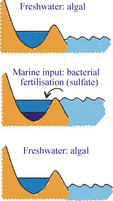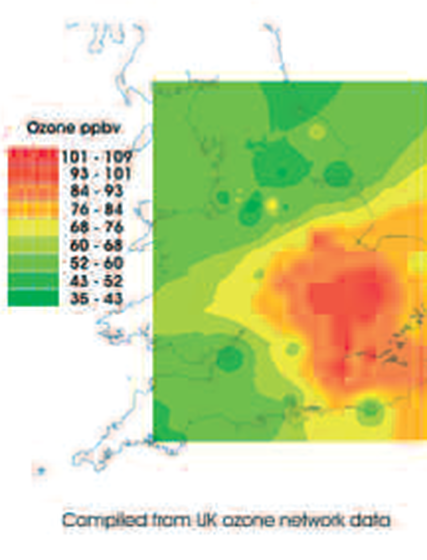Air quality and climate: Polluted Troposphere Programme
Climate change is a long-term, complex process. One major issue is how climate change will affect air quality, in particular how higher temperatures will modify emissions of a range of pollutants in the atmosphere. NERC’s Polluted Troposphere programme investigated this issue. Human activities emit a wide range of pollutants into the atmosphere that can affect climate both directly and indirectly. Direct effects include emissions of small particles, known as particulates or aerosols, that can change the Earth’s radiation balance. Indirect impacts include changing the amount of time long-lived greenhouse gases remain in the atmosphere.
|
People in the UK are well aware of the relationship between poor air quality and extremely warm weather and this is an obvious area where knowledge of atmospheric processes can bring positive benefits to both quality of life and human health. Scientists observe significantly higher levels of pollutants such as ozone, small particles and the oxides of nitrogen (collectively termed NOx) during photochemical pollution episodes, sometimes called smog. Higher temperatures cause faster chemical reactions and changes to both the rates and types of emissions. As a simplistic example, for the UK, there is a direct correlation between the severity of summertime photochemical episodes and daytime air temperature. Very high summertime air pollution, for example when ozone concentration rise above 90 parts per billion by volume (ppbV), is almost always associated with high pressures (anticyclones) and temperatures in excess of 28-30°C. Climate scientists predict that hot summers, such as those experienced during 2003 and 2006, when Europe saw substantial photochemical smog, will increase both in frequency and duration as a consequence of climate change.
|
The European heatwave in August 2003 starkly demonstrated the significance of high temperature air pollution. During a 10-dayperiod a blocking anticyclone persisted over Western Europe, with consequent air temperatures of up to 40°C. This led to severe health problems, particularly in France, where the authorities reported around 15,000 extra deaths. In the UK, temperatures regularly exceeded 30°C with the Office of National Statistics reporting over 2,000 excess deaths during the heatwave. Of this number 400-800of these deaths have been attributed to poor airquality through a combination of elevated concentrations of ozone and particulates in the atmosphere. Put in a national perspective, air pollution caused 20-40% of all excess UK deaths during the heatwave. But health was not the only issue: the heatwave caused a significant reduction in crop yield across Europe.
|
As part of NERC’s Polluted Troposphere programme, scientists made detailed observations of atmospheric composition outside London and in East Anglia to highlight where our understanding of regional air pollution was good and where it was poor. Fortuitously, researchers were making these observations north of London during the 2003 heatwave, allowing a unique and detailed insight into the key chemical and physical factors affecting the production of photochemical smog under high temperature conditions.
The heatwave was characterised by high ozone concentrations. The team observed peak levels in the UK in excess of 110 ppbV on each of the five days of the heatwave. Analysis of the collected chemicals, and meteorological data, suggests that naturally-produced (biogenic) compounds from vegetation assisted photochemical smog formation. The team showed that plants responded to heat stress by emitting large amounts of a chemical called isoprene. Vegetation in this area does not normally emit much isoprene, which is a very reactive chemical that can contribute to the formation of high levels of ozone when combined with nitrogen oxides. Calculations show that during the heatwave biogenic emissions caused by the heat accounted for 33% of regional scale ozone formation on average, and typically 40-45% on the highest temperature days. This can be compared with a calculated contribution of about 20% during the remainder of the summer period. The results suggest an important role for biogenic oxidation in regional-scale ozone formation under heatwave conditions. Further to this, new analysis points to not only increased isoprene production in plants, but also increased amounts of particulates in the atmosphere during heatwaves. |
This demonstrates that the relationship between natural emissions and poor air quality appears to be a major uncertainty in the context of a changing climate. Higher temperature may mean, for example, more plant emissions and therefore poorer air quality, emphasising the integrated nature of climate change and local air quality. Other factors such as carbon dioxide emissions, land use and future human-induced emissions are also important. The largest uncertainties are the magnitude and relative importance of many of the interactions between the atmosphere and nature.
On a national policy level, as recognised by the Department for Environment, Food and Rural Affairs (Defra), there is an important imperative to determine the links between airquality and climate policy. For example, the steps taken to reduce local and regional air pollution could be in conflict with climate goals (some pollutants such as particulates have a cooling effect on the planet) and similarly, the steps taken for climate mitigation could make local and regional air quality targets more or less attainable. Scientists and policy makers are working together on these policy trade-offs through NERC programmes such as Polluted Troposphere and NERC’s National Centre for Atmospheric Science’s Distributed Institute for Atmospheric Composition.
Atmospheric composition and air quality are intimately linked with climate and the NERC funded atmospheric programmes have shown the power of fully integrated atmospheric research.
Dr PAUL MONKS
Department of Chemistry,
University of Leicester,
Leicester, LE1 7RH, UK
[email protected]
This article originally appeared in the Natural Environment Research Council publication Our Changing Atmosphere and is reproduced here with the permission of the author. The complete article may also be seen on the ECG page of the RSC’s web site at http://www.rsc.org/Membership/Networking/InterestGroups/Environmental/bulletin.asp
Atmospheric composition and air quality are intimately linked with climate and the NERC funded atmospheric programmes have shown the power of fully integrated atmospheric research.
Dr PAUL MONKS
Department of Chemistry,
University of Leicester,
Leicester, LE1 7RH, UK
[email protected]
This article originally appeared in the Natural Environment Research Council publication Our Changing Atmosphere and is reproduced here with the permission of the author. The complete article may also be seen on the ECG page of the RSC’s web site at http://www.rsc.org/Membership/Networking/InterestGroups/Environmental/bulletin.asp



